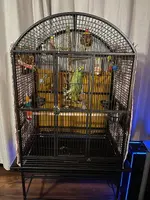Indominus
Member
Hello all, this is my first post here. Joined seeking help, hoping to get some suggestions at least.
Just rescued / purchased a 5-6 month old yellow crowned Amazon. She was at a pet shop, being marked down routinely as they were trying to get rid of her due to her behavior. I had been in the market for a parrot, didn’t plan on an Amazon at the moment; but she needed help. So here we are.
She is terrified, and I mean terrified of humans. Will not allow anyone near her, and starts making a crying / honking sound almost soon as you try along with heavy breathing and falling on her back sometimes. Does not lunge out or try to bite people, just more so attempts to flee in panic. I have not messed with her at all yet, as I wanted to gather some advice on how to beat approach this.
The owner at the store told me nothing traumatic happened during weaning (she was hand raised), but she weaned too fast and lost a couple of her nails while in the nest. Hard to say what has gone on really in here short life.. but she was being kept in a very tiny cage in a loud, high traffic shop. On top of that her feathers are all ratty and she is overall looking very stressed. All this and only 5-6 months old.
1. What should and shouldn’t I do with her right now to get her feeling safe / secure and not stressed?
2. And is the damage done to her already from being traumatized at a young age going to impact her in some ways permanently? (Possible outcomes I need to expect and be prepared for)
3. Should I go for the biggest cage I can accommodate or would a smaller cage make her feel less terrified since she’s use to not having any space?
4. Where should I start with helping her get over her terror when it comes to humans without knowing what causeit?
My apologies for the long post, I wanted to make sure all the information and her full background was provided to anyone reading.
Any help is definitely appreciated! I know this will be a difficult baby to help, and potentially take a long time. Just want to make sure I’m not doing anything to make it worse without knowing it.
Just rescued / purchased a 5-6 month old yellow crowned Amazon. She was at a pet shop, being marked down routinely as they were trying to get rid of her due to her behavior. I had been in the market for a parrot, didn’t plan on an Amazon at the moment; but she needed help. So here we are.
She is terrified, and I mean terrified of humans. Will not allow anyone near her, and starts making a crying / honking sound almost soon as you try along with heavy breathing and falling on her back sometimes. Does not lunge out or try to bite people, just more so attempts to flee in panic. I have not messed with her at all yet, as I wanted to gather some advice on how to beat approach this.
The owner at the store told me nothing traumatic happened during weaning (she was hand raised), but she weaned too fast and lost a couple of her nails while in the nest. Hard to say what has gone on really in here short life.. but she was being kept in a very tiny cage in a loud, high traffic shop. On top of that her feathers are all ratty and she is overall looking very stressed. All this and only 5-6 months old.
1. What should and shouldn’t I do with her right now to get her feeling safe / secure and not stressed?
2. And is the damage done to her already from being traumatized at a young age going to impact her in some ways permanently? (Possible outcomes I need to expect and be prepared for)
3. Should I go for the biggest cage I can accommodate or would a smaller cage make her feel less terrified since she’s use to not having any space?
4. Where should I start with helping her get over her terror when it comes to humans without knowing what causeit?
My apologies for the long post, I wanted to make sure all the information and her full background was provided to anyone reading.
Any help is definitely appreciated! I know this will be a difficult baby to help, and potentially take a long time. Just want to make sure I’m not doing anything to make it worse without knowing it.

 UPDATE: For anyone interested in an update. In the few days she's been here; she seems to "know" she is in good place. I was expecting her behavior to be a lot worse for a longer period of time upon her initial bringing home, and she may have her up's and downs yet. But she has surprised me to say the least!
UPDATE: For anyone interested in an update. In the few days she's been here; she seems to "know" she is in good place. I was expecting her behavior to be a lot worse for a longer period of time upon her initial bringing home, and she may have her up's and downs yet. But she has surprised me to say the least!